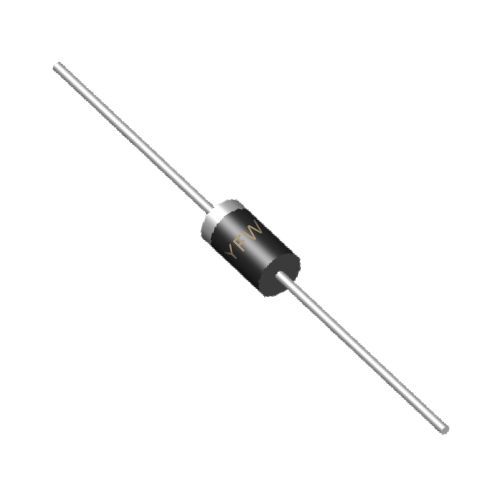A TVS diode is a specialized semiconductor device designed to protect circuits from sudden voltage surges caused by events like lightning strikes, electrostatic discharge (ESD), inductive load switching, or power grid fluctuations. Unlike regular diodes, which primarily conduct current in one direction, TVS diodes are optimized to handle extreme voltage transients by clamping the voltage at a safe level and diverting excess current to ground.
Rapid Response Time: TVS diodes react in picoseconds (10⁻¹² seconds), making them effective against high-speed transients .
High Power Handling: They can absorb surge power ranging from a few watts to several kilowatts, depending on the type and configuration .
Bidirectional Protection: Some TVS diodes (bidirectional) protect against both positive and negative voltage spikes, ideal for AC circuits, while unidirectional types are used in DC applications .
Low Leakage Current: During normal operation, TVS diodes exhibit minimal leakage, ensuring they do not interfere with the circuit’s functionality .
TVS diodes operate based on the avalanche breakdown principle. When a voltage transient exceeds the diode’s breakdown voltage (VBR), it enters a low-impedance state, allowing it to conduct large currents. This action clamps the voltage to a safe level (clamping voltage, VC), preventing damage to sensitive components downstream .
Breakdown Voltage (VBR): The minimum voltage at which the TVS diode begins to conduct under reverse bias .
Clamping Voltage (VC): The maximum voltage the TVS diode allows during a surge, which must be lower than the maximum 耐受 voltage of the protected circuit .
Peak Pulse Power (PPR): The maximum power the TVS diode can handle in a single transient event .
Response Time: The time taken for the TVS diode to transition from high to low impedance, typically within picoseconds .
TVS diodes are indispensable across diverse industries:
From smartphones to laptops, TVS diodes protect USB ports, charging circuits, and display drivers from ESD and voltage spikes during plugging/unplugging . YFW’s SMF5.0CA (SOD-123FL ), for example, offers bidirectional protection with a low clamping voltage of 9.2V, ideal for 5V-sensitive circuits .
In vehicles, TVS diodes shield ECUs, sensors, and communication buses from voltage transients caused by inductive loads (e.g., starter motors) or load dump events. YFW’s SMDJ120A (SMC ) with a breakdown voltage of 120V and clamping voltage of 190V is designed for automotive power lines .
TVS diodes ensure stable operation of PLCs, sensors, and telecom equipment by suppressing surges from lightning or faulty wiring. YFW’s SMAF10CA (SMAF ) provides bidirectional protection for data lines, with a fast response time and low capacitance to minimize signal distortion .
TVS diodes are critical in AC/DC converters and adapters to protect against mains-borne transients. YFW’s P6SMB56A (SMB offers 56V reverse stand-off voltage and 82.4V clamping voltage, making it suitable for 12V and 24V power systems .
YFW is a leading manufacturer of TVS diodes, renowned for reliability, innovation, and precision. Here’s what sets our products apart:
YFW offers TVS diodes in various configurations, including:
Unidirectional and Bidirectional: Tailored for DC and AC applications.
Surface Mount (SMD) and Through-Hole: Options like SMA, SMB, SMC, and DO-214AC for space-constrained or high-power designs .
High-Power Solutions: Models like SMDJ120A (1500W peak power) for automotive and industrial use .
All YFW TVS diodes undergo rigorous testing to meet international certifications, including UL, RoHS, and REACH . Our ISO 9001:2015-certified facilities ensure consistent quality, while AEC-Q101-compliant products (e.g., automotive-grade TVS diodes) adhere to the highest industry benchmarks .
YFW collaborates with clients to develop tailored TVS solutions for unique applications. Whether you need low-capacitance TVS for high-speed data lines or high-temperature-rated diodes for harsh environments, our engineering team provides end-to-end support.
Choosing the optimal TVS diode involves considering:
Voltage Requirements: Ensure the TVS diode’s VBR and VC match the circuit’s operating voltage and maximum 耐受 voltage .
Power Handling: Select a TVS diode with sufficient PPR to absorb the expected surge energy .
Response Time: For high-speed applications (e.g., USB 3.0), prioritize TVS diodes with sub-nanosecond response times .
Package and Capacitance: SMD packages like SOD-123FL are ideal for compact designs, while low-capacitance TVS diodes (e.g., YFW’s SMF5.0CA) minimize signal degradation .
TVS diodes are the backbone of circuit protection, ensuring electronics operate reliably in an increasingly volatile electrical environment. YFW’s TVS solutions combine cutting-edge technology with rigorous quality control, delivering robust protection for applications ranging from consumer electronics to automotive systems. By partnering with YFW, you gain access to a trusted supplier committed to innovation, sustainability, and customer success.
For detailed product specifications and technical support, visit
YFW’s official website or contact our team today
